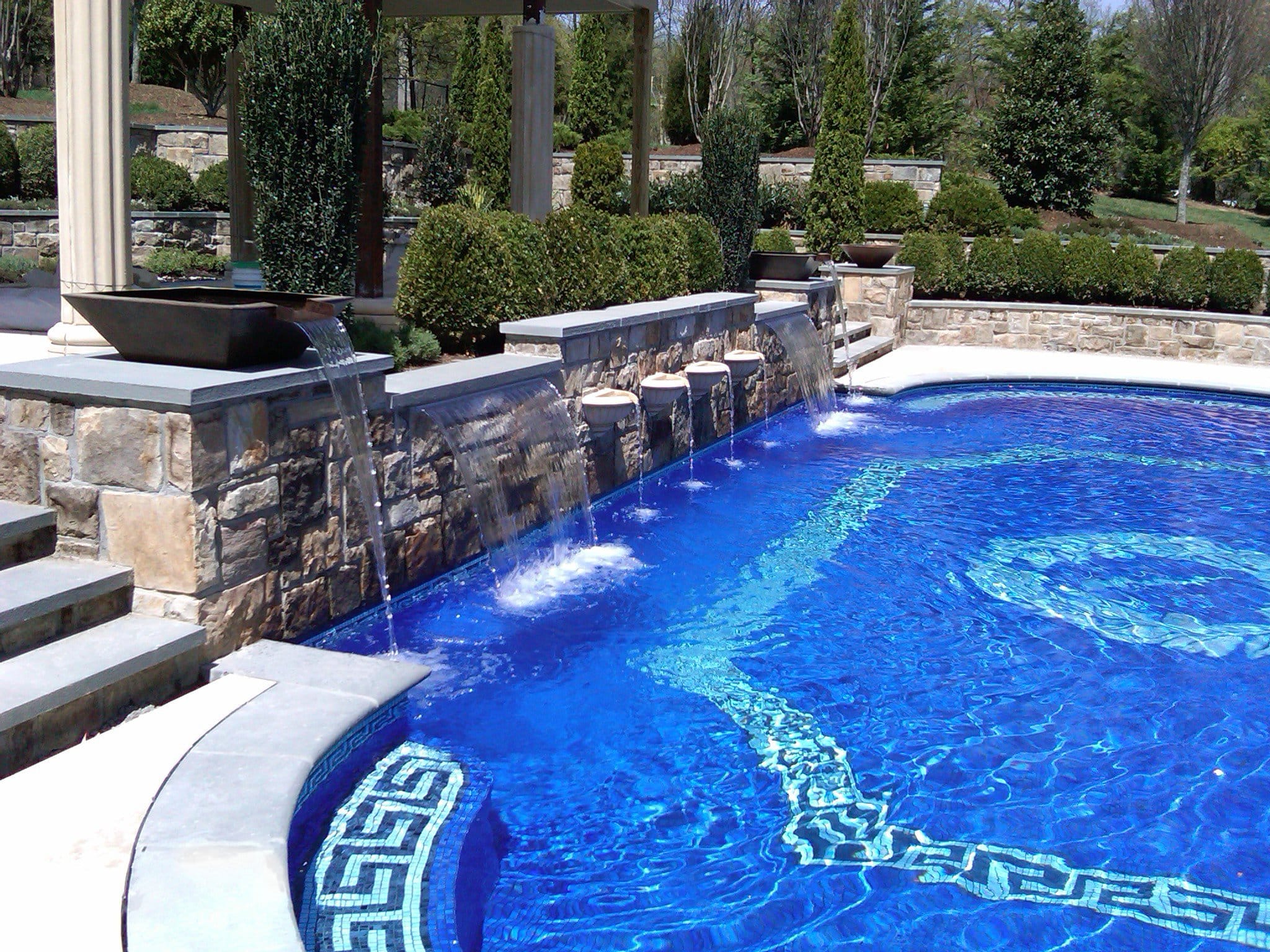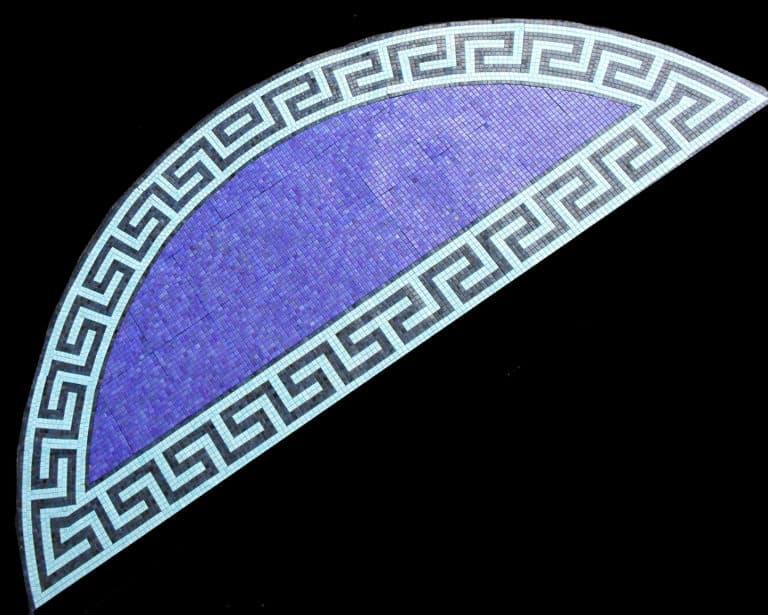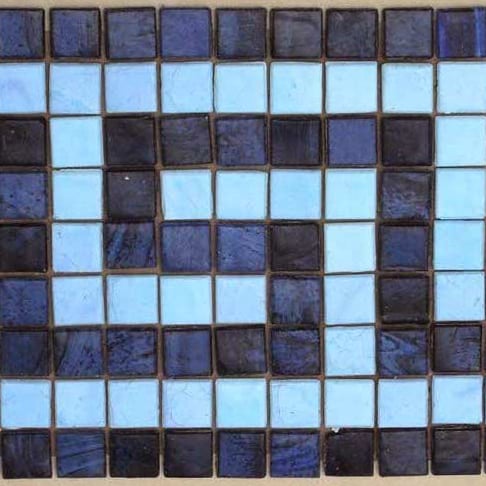
Blending Greek Style with Modern Architecture in Pool Design
The Outdoor Greek Style Pool Area
Designed by Lewis Aquatech Pools in Chantilly, Virginia, this pool has received much praise from both the pool industry and the public.
This all-tile mosaic pool features a Greek Key border on all the steps, benches, and the floor. The center of the pool is adorned with a mosaic wreath, featuring the letter N.
More Information

Baja Shelf
The Versatile Baja Shelf for Residential Pools
A Baja shelf is an expansive shallow-water step that provides a convenient entry point into a swimming pool. With a typical depth of 8-16 inches, it serves as a functional addition to residential pools for bathers of all ages.
This feature, which may also be referred to as a Baja step, Acapulco shelf, tanning ledge, Shamu shelf, shallow reef step, thermal ledge, or sun shelf, brings a touch of luxury to residential pools. The Baja shelf is often finished with a Greek Key border around the edge, adding a touch of elegance to the design.
The Symbolism of the Greek Key
In ancient Greece, the Greek Key was a symbol of infinity and the eternal flow of things, due to its unbroken and continuous design.
Today, the Greek Key continues to represent eternity and unity, as the continuous line pattern holds strong symbolic meaning. In this pool, the Greek Key border is prominently displayed around the waterline and on the pool floor, adding a touch of timeless elegance to the design.
Design Your Own Greek Style Pool
Call us today to have us design your own Greek Style pool, featuring the iconic Greek Key design. Experience the timeless beauty and symbolism of this classic motif in your own outdoor oasis.

Contact US
Grecian and Roman Pools
The Timeless Beauty of Grecian Shaped Pools
Grecian shaped pools are renowned for their classic look, which begins with a basic rectangular shape and features truncated or “cut off” corners.
This unique shape can complement classical architectural styles and backyard garden areas, creating a harmonious and timeless aesthetic. Although some pool area may be lost with the cut off corners, the resulting look is well worth it for those seeking a touch of classical elegance in their outdoor space.
The Elegance of Roman Shaped Pools
The Roman shaped pool is another classic design, featuring a rectangle with added semi-circles at the ends and sides.
This timeless design is a beautiful addition to any outdoor space and provides a perfect balance of straight lines and curved shapes. Whether you’re looking to add a touch of classical elegance to your backyard or simply enjoy the timeless beauty of a well-designed swimming pool, a Roman shaped pool is a great choice.
The Rounded Beauty of Grecian Shaped Pools
Grecian shaped pools are known for their rounded design, featuring elegant curves that add a touch of sophistication to any outdoor space.
The semi-circles in the design provide the perfect place to add steps, making the pool more functional and accessible for bathers of all ages. By combining the classic look of Grecian pools with the added elegance of Roman shaped pools, pool designers can create a unique and remarkable design that is both beautiful and functional.
Finding the Perfect Match for Your Home and Landscape
When it comes to choosing the best shaped swimming pool, the key is to find a design that seamlessly blends with your home and landscape. Whether you have a specific theme in mind or simply want to complement the look and feel of your outdoor space, the shape of your swimming pool can play a crucial role in creating a harmonious and cohesive look. At the end of the day, the best shaped swimming pool is one that perfectly matches the unique style and character of your home and landscape.Greco-Roman Architecture
Classical Architecture: The Five Orders
The five orders of classical architecture – Doric, Ionic, Corinthian, Tuscan, and Composite – were named in later Roman times. The first three were originally created by Greek architects, while the latter two were a blending of existing styles.
The Corinthian column, invented in Athens in the 5th century BCE, is similar to the Ionic but features a more decorative capital with stylized acanthus leaves and fern leaves. Acanthus leaves are a common feature in Greco-Roman design and are frequently used in our designs, especially when inspired by Italian or Greek architecture.
Classical Architecture: The Science of Perception
In classical architecture, much effort was put into creating temples in prominent positions and using sophisticated geometry to create optical illusions. Architects would thicken the lower parts of columns, thicken corner columns, and make columns lean slightly inward, giving the building a perfectly straight appearance from a distance.
This pool sits below a building with fluted columns in a Grecian style, creating an atmosphere reminiscent of ancient temples. The attention to detail in classical architecture, including the use of optical illusions, makes it a timeless and enduring style that continues to inspire designers and architects today.
